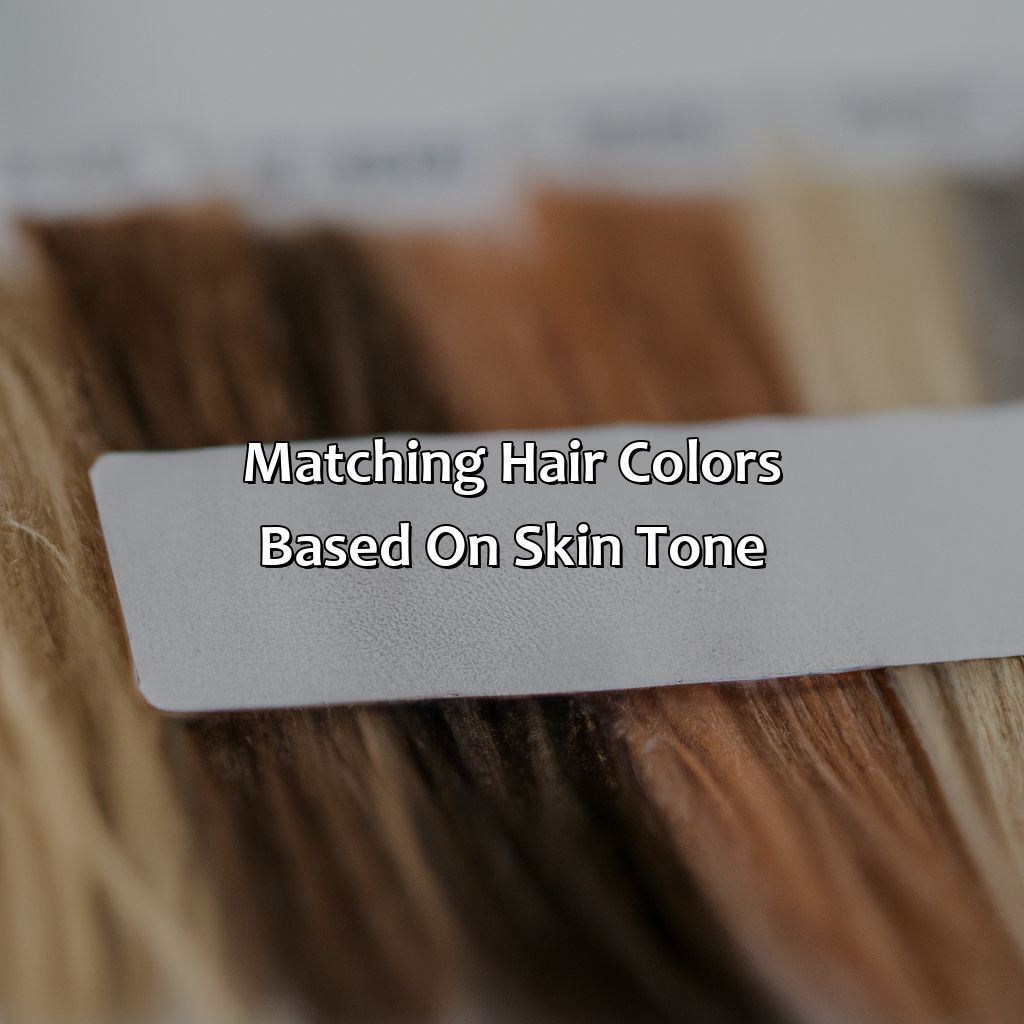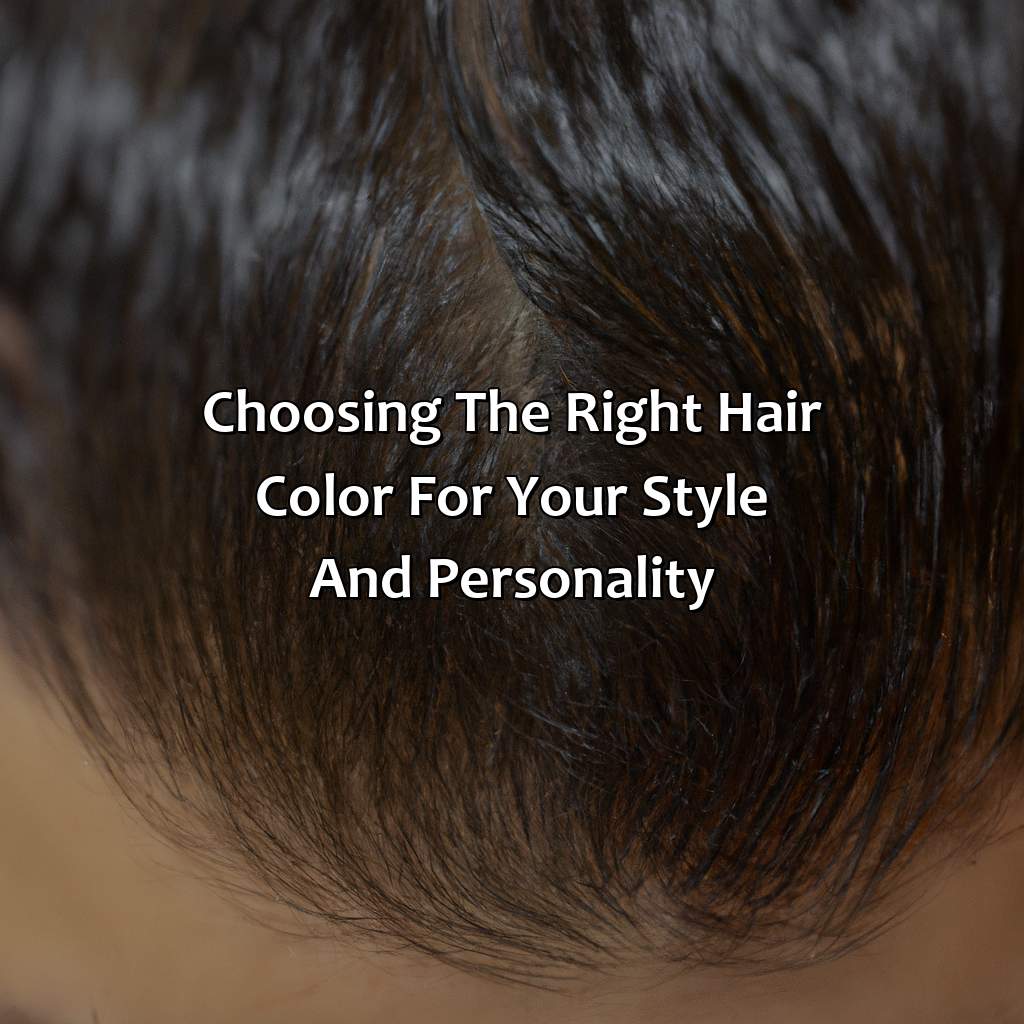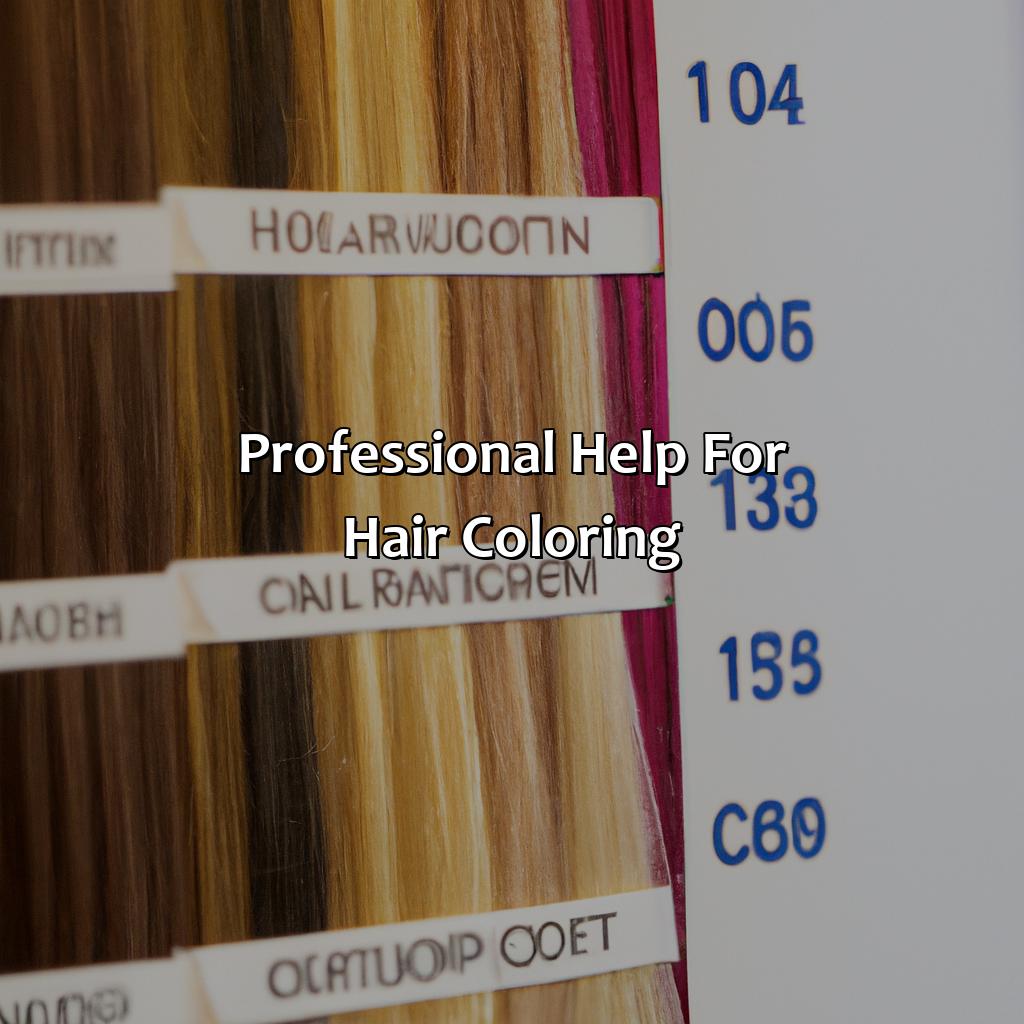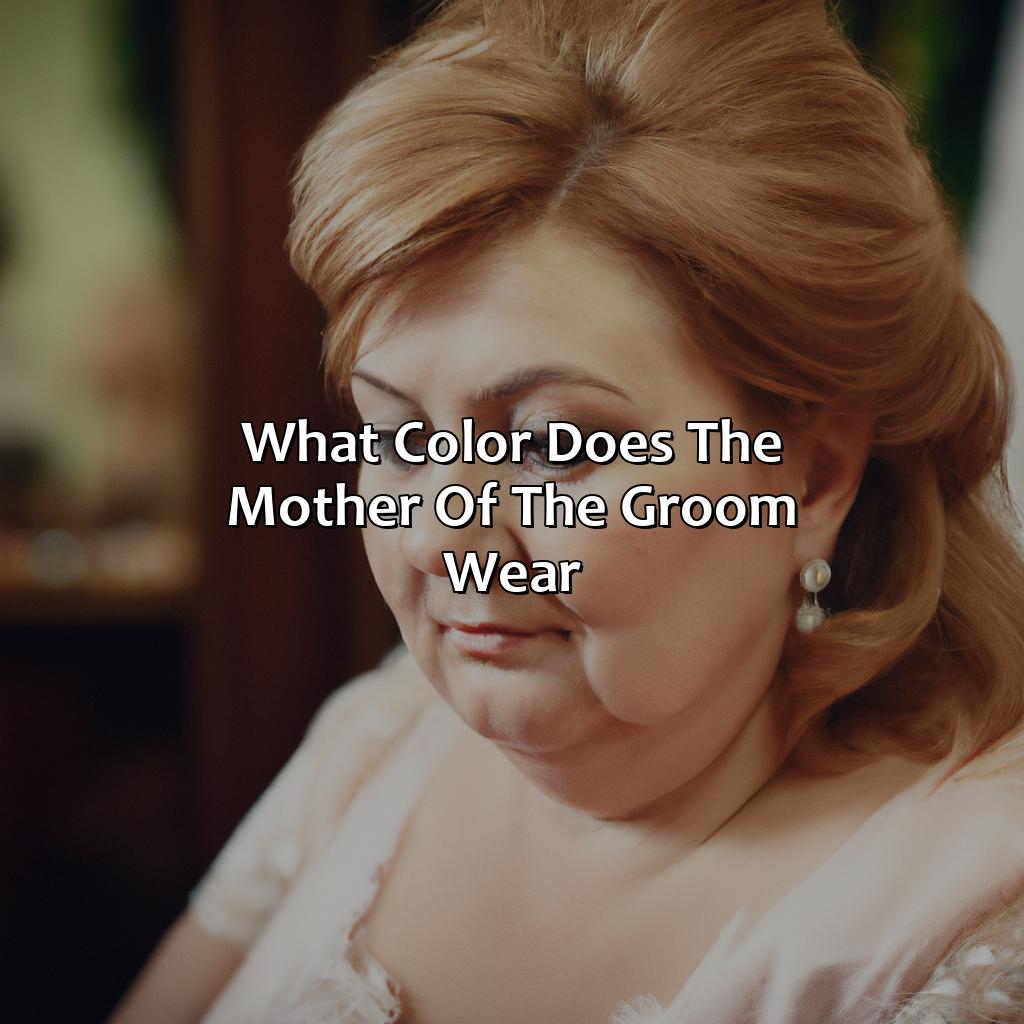Key Takeaway:
- Determining your skin tone is crucial in choosing the right hair color: Understanding your skin undertones is important in determining your skin tone, which will help you determine the hair colors that will suit you best. Warm skin tones best suit warm hair colors like honey and caramel, while cool skin tones work best with ash and platinum tones.
- Consider your natural hair color and personality: When selecting a hair color, consider your natural hair color and the color that best represents your personality. This will help narrow down your options and lead you to the hair color that will look best on you.
- Consult a professional for better results and maintenance: Consulting a professional stylist is crucial in achieving the desired hair color and maintaining it. They can give you advice on upkeep and recommend products and techniques that will help keep your hair looking healthy and vibrant.
Determining Your Skin Tone
Photo Credits: colorscombo.com by Keith Torres
To get the perfect hair color for you, first work out your skin undertones. This is essential! To make things easier, we’ll cover the basics of understanding skin undertones. We’ll help you identify your skin undertones and determine your skin tone in the sections below.
Understanding Skin Undertones
Skin undertones play a significant role in determining the right hair color for an individual. Understanding skin undertones is essential in picking the right shade of hair dye that will complement the skin’s natural color, creating a cohesive and harmonious look. Skin undertones are categorized into three groups: warm, cool, and neutral, based on the colors present beneath the skin’s surface.
Knowing your undertone is crucial in identifying which colors work well with your complexion. Undertones affect how colors appear on one’s skin. To identify your skin undertone, check your veins’ color under natural light. Green veins indicate warm undertones, while blue or purple veins indicate cool undertones. People with neutral undertones have difficulty determining their tint as they lie somewhere between warm and cool.
Additionally, one can inspect their jewelry preferences to help them determine their skin’s underlying tone. Warm-toned people tend to prefer gold jewelry while those with cool tones prefer silver pieces. Neutral-toned people would typically look good wearing any metal.
Pro Tip: Remember that identifying skin undertones should always come before choosing hair dye color to avoid mismatching your hair against your complexion. Your skin undertones hold the secret to finding the perfect hair color, so get ready to uncover the truth.
Identifying Your Skin Undertones
Determining the undertones of your skin is crucial in finding the right hair color that suits you. Knowing your skin undertone can also help with choosing the right makeup and clothing colors.
By examining the veins on your wrist, you can identify whether you have warm, cool, or neutral undertones. If your veins appear greenish, you have a warm undertone; if they appear bluish, you have a cool undertone; and if they are a mix of blue and green, you have a neutral undertone.
Additionally, another way to determine the skin’s undertones is by observing how it reacts to different colors. If your skin appears more radiant when wearing gold jewelry than silver jewelry, it indicates warm undertones. However, if it appears more vibrant with silver jewelry than gold jewelry, it indicates cool undertones.
Pro Tip: Consulting with a professional stylist or colorist can provide more insight into identifying your skin’s true undertones to ensure accurate hair color recommendations.
Identifying your skin tone is like playing detective, but instead of clues, you’re following the undertones.
Determining Your Skin Tone
Understanding Where You Fit – Discovering Your Skin Tone and Its Impact on Hair Coloring
The first step in finding your ideal hair color is understanding your skin tone. A person’s skin tone can be classified as warm, cool, or neutral based on their undertones. Undertones can be identified by analyzing the veins on the wrist and determining whether they are blue or green. Warm undertones tend to have green veins, while cool undertones have blue veins. Neutral undertones have both green and blue veins.
Identifying your skin’s tone is crucial because choosing the wrong shade of hair color for your skin type could cause an unflattering appearance. For instance, if you have a cool skin tone and added red highlights to your hair, it might clash with your complexion.
To determine your skin tone accurately, observe how sunlight affects it. People with cool tones would turn pink when exposed to sunlight while individuals with warm tones would tan more quickly.
Knowing the extent of precisely identifying one’s precise skin tone is vital in selecting a compatible hair color that enhances one’s physical appearances.
Discovering which colors complement one’s features helps create a cohesive look that ties together personality and style choices.
Are you aware of how much impact merely defining your precise skin tone could bring out?
Don’t let poor hair color selection undermine all of the glowing physical features that complement who you truly are!
Find the perfect shade that will make your skin tone and hair color a match made in heaven.
Matching Hair Colors Based on Skin Tone

Photo Credits: colorscombo.com by Zachary Thompson
Your perfect hair color is dependent on your skin tone. To find the ideal one, look to the “Matching Hair Colors Based on Skin Tone” section. It’s divided into three: Warm, Cool and Neutral Skin Tones and Hair Colors. Each of these sections will give you insights into the best hair color for your skin tone.
Warm Skin Tones and Hair Colors
For those with warm skin tones, hair color can be a tricky decision. Warmer hair colors such as golden blondes, honey browns and copper reds complement the yellow undertones of the skin beautifully. One should look for warm hair colors that have hints of gold or caramel to bring out the warmth in their skin tone. It is also important to avoid cool tones like ashy or platinum shades, which can make one appear washed out and dull. For a more natural and warm look, one can opt for highlights or ombre that blend well with their base color.
When considering your hair’s colored tones alongside your warm skin tones, it’s imperative to avoid going too pale or overly cool-toned. These hues will wash you out and bring attention to any redness or sallow undertones you could have on show. Instead, stick with rich shades including chestnut browns, chocolate browns paired with some slight mahogany play up its red-leaning undertone.
To achieve a cohesive overall appearance that complements your warm skin tone perfectly, it is best to stick with warmer hair colors. By choosing such hues that enhance the warm undertones of your complexion rather than detract from it ones will look perfect. In this way, individuals can match their personality while looking chic and fashionable.
Fact: According to WebMD, having warmer complexions means people tan easily and seldom burn when exposed to the sun for long periods.
Ready to give your hair a cool new look? Here’s how to pick the perfect hair color to match your cool skin tone.
Cool Skin Tones and Hair Colors
Cool toned skin has undertones of pink, red or blue. Hair colors that compliment these cool skin tones include ashy shades with blue or violet undertones such as platinum blonde, silver, ash brown and jet black. These colors enhance the coolness of the complexion and create a beautiful contrast.
It is important to avoid warm hair colors like copper, golden blonde or warm brown as they clash with cool skin tones and can make the complexion appear washed out.
To further emphasize the coolness of the complexion, toning shampoos or color-depositing conditioners in shades of blue or purple can be used to counteract any unwanted brassy tones in dyed hair.
Remember to keep in mind personal style and preference when choosing a hair color. Professional advice from a stylist can also help guide towards a flattering shade that compliments cooler skin tones.
Whether you’re feeling hot or cold, neutral skin tones can rock any hair color bold.
Neutral Skin Tones and Hair Colors
Individuals with a neutral skin tone have a mixture of both warm and cool undertones in their complexion. This means that they can consider both warm and cool hair colors without much limitation. Neutral skin tones are quite rare to find, but if you have a difficult time deciding between warm and cool hair colors, then you may have a neutral skin tone.
When selecting hair colors for neutral skin tones, it’s important to consider the natural hair color as well as personal preference. Thorough consultation with a professional stylist helps to choose the best-suited hair color based on the undertones of the individual’s neutral skin tone.
It is essential to avoid using any hair color that could overwhelm the balanced undertones of neutral skin tones or make one look washed out. The ideal approach is to opt for shades that enhance your natural features while still being versatile enough to complement any outfit or occasion.
According to hairstylist L’Oreal Paris, individuals with neutral skin tones can choose shades like black, rich browns, dark blondes or honey blondes. These colors will bring warmth and depth to their natural features while not overpowering them.
Fact: According to beauty expert Paula Begoun, wearing clothing that complements an individual’s neutral skin tone can make them appear healthier and more vibrant.
Your hair color should match your personality, not your neighbor’s, unless you share the same twisted sense of humor.
Choosing the Right Hair Color for Your Style and Personality

Photo Credits: colorscombo.com by Alexander Robinson
To pick the perfect hair color for you, think about these things: your natural hair color, the texture and structure of your hair, and your personality. This way, you will get a hair color that looks great on you and that truly showcases your individual style and traits.
Consider Your Natural Hair Color
Begin by acknowledging the importance of considering one’s natural hair color when choosing a new shade. Taking into account your natural hair color can help create a cohesive and flattering look. Look at the undertones in your current hair color to determine what would complement your skin tone best.
When considering a new hair color, it’s important to keep your natural hair color in mind. Ideally, you should choose a shade that is not too far from your current hue, but rather enhances it. This will make any regrowth less noticeable and ensure that the final result looks more natural.
Looking specifically at the undertones of your natural hair color can also be helpful when choosing a new shade. Consider whether there are warm or cool tones present, and select a hue that amplifies those colors. Additionally, if you’re looking for a dramatic change, speak with a stylist to see which options would work best for your specific hair type.
It’s interesting to note that throughout history, people have used natural ingredients like henna or walnut shells to change their hair color. Today we have access to many more advanced coloring techniques and products which allow us to achieve almost any shade imaginable while still taking our natural base into consideration.
Your hair texture and structure are key to finding the perfect color that won’t leave you feeling like you’re wearing a cheap wig.
Know Your Hair Texture and Structure
Understanding the structure and texture of your hair is crucial in determining the right hair color. Hair texture refers to the diameter of individual hair strands, whereas hair structure refers to whether your hair is straight, wavy, curly or coily. These factors determine how well a certain color may take hold on your strands and how long it can last. Additionally, they give insight into which colors will complement the way your natural hair already flows.
It’s important to consult with a professional stylist who can help you find the perfect shades that suit both your complexion and hair’s unique composition.
Hair texture and structure also influence how much processing power your strands have – making it more important to adjust based on them or risk over-processing or damage. Only some colors work better for fine or porous textures while others perform better in thick or coarse hairs giving an idea of what color pigment might work best for your locks. Knowing this can help you minimize any potential damage that dyeing could cause while ensuring that you get a result that complements all aspects of your beauty.
Historically, people brushed off considering their texture when picking new colors for fear of unwanted results instead taking only tones into account. However, modern beauty has evolved such knowledge becoming essential -even crucial- to maintain healthy-looking color-treated locks at home! So always talk with experienced stylists about how each tone could interact with yours given the in-depth knowledge required to match shade pigments that seamlessly blend.
Your hair color says a lot about your personality, so let your true colors shine through with these tips.
Choosing a Hair Color Based on Your Personality
Choosing the Best Hair Color that Compliments Your Personality
The color of your hair plays a significant role in enhancing or diminishing your personality. It is crucial to pick a hair color that matches your personality, which makes you feel confident and comfortable in your skin. Upgrading your hair color is a chance to showcase the vibrant, bold, or subtle hues that complement who you are.
When selecting a hair color based on personality, consider highlighting or lowlighting methods for enhancing movement and dimensionality. You can choose from an extensive range of styles and variations that reflect your temperament. For instance, if you have an outgoing personality, consider warm colors like reds and oranges that will make you stand out in social gatherings.
Another aspect to keep in mind when choosing hair color based on personality is the level of commitment to maintenance it requires. High-maintenance shades like bright jewel-toned colors may be challenging to maintain without regular touch-ups, whereas natural hues such as browns and blondes are less demanding.
Pro Tip: When seeking expert advice on how best to match your hair color with your personality, consider consulting with a professional hairstylist who can recommend the most suitable dye job for you while ensuring that it meets all your needs. When in doubt, leave it to the professionals – especially when it comes to hair coloring.
Professional Help for Hair Coloring

Photo Credits: colorscombo.com by Donald Adams
Achieving the perfect hair color is no easy feat! Professional help is essential. Talking to your stylist is key, so you can get the right shade for you. Let’s discuss the importance of consulting a pro, communicating with them, and nailing the desired hair color result.
The Importance of Consulting a Professional
Consulting with a professional when considering hair coloring is crucial. A professional stylist can provide insight into what colors will best suit your skin tone, hair type, and personal preferences. It’s important to communicate your desired outcome and be open to their expertise.
By consulting a professional, you can avoid potentially damaging mistakes that could lead to costly color correction appointments. They have the knowledge and experience to address any concerns or questions you may have about the process and can guide you towards achieving your ideal hair color.
To ensure optimal results, it’s important to trust in the process and follow the stylist’s recommendations. This may include scheduling regular touch-up appointments or incorporating new hair care routines into your daily routine.
In summary, it cannot be overstated how critical consulting a professional hairstylist is when contemplating a new hair color. Their expertise and guidance can ultimately be the difference between a stunning transformation and a disappointing result.
Make sure your communication with your stylist is clear, so they don’t accidentally give you a ‘I just got a bad breakup’ haircut instead of the perfect hair color match.
Communication with Your Stylist
To ensure that you achieve the desired hair color result, effective communication with your stylist is crucial. It’s important to convey the specifics of what you want to your stylist while also being receptive to their suggestions and expertise. Being informed about different hair color techniques can also help with effective communication. Using terms such as “subtle highlights” or “soft balayage” can better convey your vision rather than simply saying you want a “lighter shade“. Open and honest communication will also allow your stylist to understand any concerns or sensitivities you may have regarding certain products or chemicals used during the coloring process.
Pro Tip: Bring in pictures of the desired hair color and style to help in communicating with your stylist for best results.
Get the desired hair color result by trusting a professional, communicating effectively, and being patient with the process.
Achieving the Desired Hair Color Result
Achieving the perfect hair color can be a daunting task, but with the right approach, achieving the desired result is not impossible. Here’s how you can achieve your desired hair color:
- Consult a Professional: The first step is to consult a professional stylist who can assess your hair and recommend the ideal treatments and products. They take into account your skin tone, natural hair color, and texture when suggesting a shade that would suit you best.
- Communicate Clearly: Ensure that you communicate clearly with your hairstylist about specific colors or shades you have in mind. Being on the same page is vital to achieving a satisfactory outcome.
- Follow Protocol: Be patient and allow the professionals to work their magic without getting in the way or demanding shortcuts. Taking care of your hair before coloring it makes it easier for stylists to attain desired results.
When it comes to achieving hair color goals, persistence is key. Be open-minded because sometimes trying out new things might lead to surprising results that go beyond what was initially imagined.
It’s wise to remember that every individual’s inspirational journey towards their desired result will always be unique – much like one woman who found her way through trying different dye techniques before settling on her favorite shade of blonde, which she has maintained for almost two years now!
Keeping up with your hair color maintenance is like having a high-maintenance pet, but with less barking and more compliments.
Maintenance and Upkeep

Photo Credits: colorscombo.com by Larry Allen
Want to keep your hair color looking its best? Check out the section called ‘Maintenance and Upkeep‘ for easy and simple solutions. Discover techniques to maintain your hair color and avoid damage. Also, learn why post-color haircare is so important. We’ve got you covered with solutions for that too!
Basic Hair Color Maintenance Tips
Maintaining your hair color is essential to keep it looking healthy and vibrant. Here are some tips you can follow for the basic maintenance of your hair color:
- Use a sulfate-free shampoo to avoid stripping the color from your hair.
- Condition your hair regularly to prevent dryness and frizziness.
- Avoid using hot tools such as straighteners or curling irons frequently as they can damage the color-treated hair.
- Wear a hat or use a UV protectant spray when exposed to sunlight for long periods, as it may fade the color.
- Use a color-safe leave-in conditioner to reduce tangles and maintain the vibrancy of hair color.
- Do not wash your colored hair too often as it can accelerate fading.
To ensure that your newly colored locks stay glossy and lively, follow these basic maintenance tips.
It is important to note that every individual’s hair structure is unique; therefore, one should take into consideration their specific hair type while choosing products.
Hair coloring dates back thousands of years ago, where Ancient Egyptians were the first to use Henna to tint their strands. Over time, modern methods have been developed, ensuring more natural-looking colors while maintaining healthy strands.
Save your hair color from fading away with these damage prevention techniques.
Hair Color Damage Prevention Techniques
Preventing damage to your hair color is crucial in maintaining a healthy, vibrant look. There are several techniques you can use to keep your hair color looking its best without causing damage.
One way to prevent hair color damage is to limit exposure to heat styling tools like flatirons, curling irons, and blow dryers. Overuse of these tools can cause your hair color to fade over time due to excessive heat exposure.
Another technique involves using gentle shampoos and conditioners that are specifically formulated for colored hair. These products help maintain the integrity of your hair color by adding moisture and protection to your locks.
It’s also important to avoid harsh chemicals and treatments that can strip your hair color away. These include things like chlorine from swimming pools or harsh clarifying shampoos that can strip away natural oils.
By incorporating these damage prevention techniques into your daily routine, you can help maintain the vibrancy and longevity of your hair color. Remember to consult with a hairstylist or professional for additional advice on how best to care for your specific hair type.
Importance of Post-Color Haircare
Proper post-color haircare is of utmost importance to maintain the health and vibrancy of your colored hair. Neglecting this step can lead to fading, dryness, split ends, and overall damage to your hair. Therefore, it is essential to follow a regular haircare regimen that takes into account your specific hair needs.
After coloring your hair, it’s crucial to use sulfate-free shampoos and conditioners designed for color-treated hair. These products contain ingredients that prevent color-fading, while also moisturizing the hair. You can also use a deep conditioning treatment once a week to nourish and repair any damage caused by coloring.
Lastly, avoid excessive heat styling and use a thermal protectant spray before using hot tools such as straighteners or curling irons. Additionally, protect your colored hair from UV rays by wearing hats or applying a leave-in conditioner with SPF.
By incorporating these post-color haircare tips into your routine, you can prolong the life of your new hairstyle and maintain its vibrancy in between salon visits.
Five Facts About How To Know What Hair Color Suits You:
- ✅ Your skin tone is one of the most important factors to consider when choosing a hair color that suits you. (Source: Good Housekeeping)
- ✅ Your eye color can also help determine which hair color will complement your features best. (Source: Hola! USA)
- ✅ Consulting with a professional hair stylist can help you find the perfect shade for your hair. (Source: Elle)
- ✅ Trying on wigs in different colors can give you a better idea of how a certain shade will look on you. (Source: InStyle)
- ✅ Consider your lifestyle and the amount of maintenance a certain hair color may require before making a decision. (Source: Glamour)
FAQs about How To Know What Hair Color Suits You
1. How can I determine what hair color suits me?
Answer: There are various factors to consider when determining the best hair color that suits you. Skin tone, eye color, and natural hair color are all important factors to consider. Additionally, think about your personal style and preferences before making a decision.
2. Is it possible to find a hair color that flatters all skin tones?
Answer: Yes, there are some hair colors, such as dark brown and caramel, that are flattering on most skin tones. However, it’s still important to consider your unique features and characteristics when selecting a hair color.
3. Can I determine the best hair color for me without visiting a salon?
Answer: While it’s always best to seek the advice of a professional hairstylist, there are some online hair color consultation tools that can help you narrow down your options. However, keep in mind that these tools may not provide the most accurate results.
4. Should I consider changing my hair color based on the season?
Answer: It’s not necessary to change your hair color based on the season, but some people prefer to do so. For example, lighter hair colors may be more popular in the summer, while darker shades may be more popular in the fall and winter.
5. Will highlights or lowlights be a better option for me?
Answer: The decision between highlights and lowlights depends on your personal style and preferences. Highlights are typically a better option if you want a brighter, more vibrant look, while lowlights tend to create a more subtle, natural effect.
6. How often should I dye my hair?
Answer: This depends on the type of hair color you choose and how quickly your hair grows. Some hair colors may require touch-ups every 4-6 weeks, while others may last several months. It’s important to follow the instructions of your hairstylist or the product you are using.






